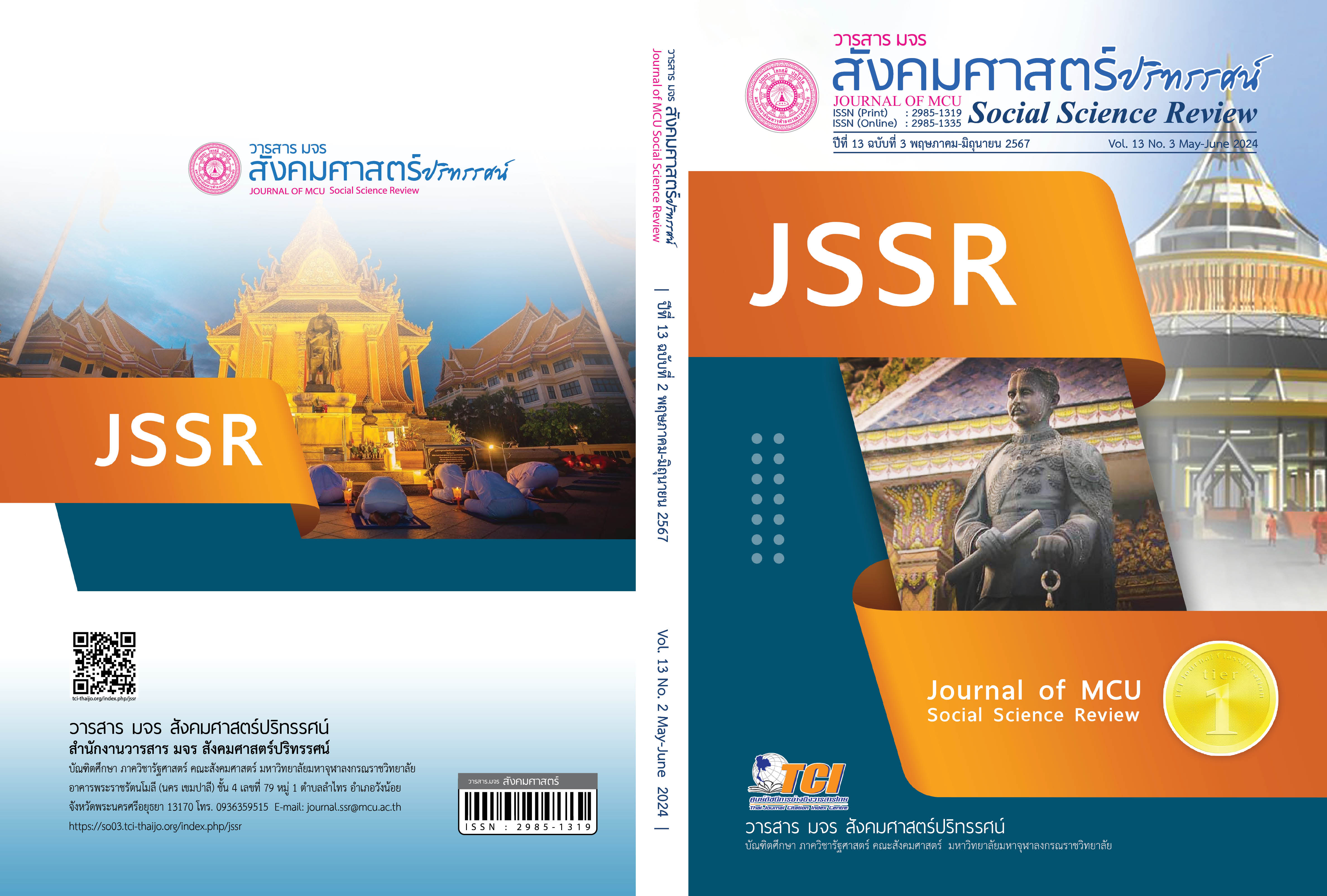การพัฒนาคุณค่ากิจกรรมการท่องเที่ยวในแหล่งท่องเที่ยวคชบาล ของประเทศไทยด้วยแนวคิดความน่าหลงใหลในจุดหมายปลายทาง
คำสำคัญ:
กิจกรรมการท่องเที่ยวช้าง, ความน่าหลงใหลของจุดหมายปลายทาง, สภาพแวดล้อมของแหล่งท่องเที่ยวคชบาลบทคัดย่อ
บทความวิจัยนี้มีวัตถุประสงค์ 1. ศึกษาความสัมพันธ์ของลักษณะสภาพแวดล้อมและรูปแบบกิจกรรมการท่องเที่ยวคชบาล 2. ศึกษาความสัมพันธ์ของลักษณะของสภาพแวดล้อมและรูปแบบกิจกรรมการท่องเที่ยวในแหล่งท่องเที่ยวคชบาลกับความน่าหลงใหลของแหล่งท่องเที่ยวคชบาล และ 3. เสนอแนวทางการพัฒนาคุณค่าของกิจกรรมการท่องเที่ยวในแหล่งท่องเที่ยวคชบาลของประเทศไทย เป็นการวิจัยเชิงปริมาณ กลุ่มตัวอย่าง คือ นักท่องเที่ยวชาวไทยในแหล่งท่องเที่ยวคชบาล จำนวน 392 คน โดยการสุ่มกลุ่มตัวอย่างแบบเจาะจงและแบบโควต้า ใช้เครื่องมือเป็นแบบสอบถาม สถิติที่ใช้ ได้แก่ การวิเคราะห์ค่าสหสัมพันธ์เพียร์สัน และการวิเคราะห์การถดถอยพหุคูณ
ผลการวิจัยพบว่า 1. ลักษณะของสภาพแวดล้อมมีความสัมพันธ์ปานกลางกับรูปแบบกิจกรรมการท่องเที่ยว คือ ทำให้นักท่องเที่ยวได้รับประสบการณ์การท่องเที่ยวที่ดี อยากกลับมาท่องเที่ยวอีก และ 2. มีความสัมพันธ์ปานกลางกับความน่าหลงใหลของแหล่งท่องเที่ยวคชบาล คือ เป็นแหล่งท่องเที่ยวที่ดีและแปลกใหม่ ทำให้อยากกลับมาท่องเที่ยวอีกครั้ง 3. การผสมผสานของสภาพแวดล้อมทางธรรมชาติ วัฒนธรรม ประวัติศาสตร์ กับการสร้างกิจกรรมการท่องเที่ยวบนวิถีคุณค่าของช้าง ทำให้นักท่องเที่ยวทุกกลุ่มชื่นชอบ
เอกสารอ้างอิง
กรมการท่องเที่ยว. (2558). แผนปฏิบัติการพัฒนาแหล่งท่องเที่ยวที่มีศักยภาพของประเทศ พ.ศ. 2558-2560. กรุงเทพฯ: กรมการท่องเที่ยว.
สำนักควบคุม ป้องกัน และบำบัดโรคสัตว์. (2552). รายชื่อปางช้างในประเทศไทย. สืบค้น 17 สิงหาคม 2562, จาก https://shorturl.asia/vOaHZ
Bansiddhi, P. et al. (2018). Changing trends in elephant camp management in northern Thailand and implications for welfare. PeerJ, 6(3), 1-30.
______. (2020). Elephant tourism in Thailand: Areview of animal welfare practices and needs. Journal of Applied Animal Welfare Science, 23(2), 164-177.
Best, J. W. (1981). Research in Education. New Jersey: Prentice – Hall.
Carr, N. & Broom, D. M. (2018). Tourism and Animal Welfare. Wallingford: CABI.
Cochran, W. G. & Chambers, S. P. (1965). The planning of observational studies of human populations. Journal of the RoyalStatistical Society: Series A, 128(2), 234-255.
Dissanayake, D. (2016). Promoting Elephant Friendly Tourism in Sri Lanka. Sri Lanka: University of Kelaniya.
Lainé, N. (2018). Asian elephant conservation: too elephantocentric? Towards a biocultural approach of conservation. Asian Bioethics Review, 10(4), 279-293.
Liu, C. R. et al. (2017). Destination fascination: Conceptualization and scale development. Tourism management, 63(1), 255-267.
Manhas, P. S. et al. (2016). Role of tourist destination development in building its brand image: A conceptualmodel. Journal of Economics, Finance and Administrative Science, 21(40), 25-29.
Pabel, A. & Mkono, M. (2021). The Elephant Tourism Business. Songkhla: CABI.
Srinok, N. (2020). Marketing communication tools for elephant camp business a case study of Ayutthaya elephant palace & royal kraal. Bankkok: Rajamangala University of Technology Phra Nakhon.
ดาวน์โหลด
เผยแพร่แล้ว
รูปแบบการอ้างอิง
ฉบับ
ประเภทบทความ
สัญญาอนุญาต
ลิขสิทธิ์ (c) 2024 วารสาร มจร สังคมศาสตร์ปริทรรศน์

อนุญาตภายใต้เงื่อนไข Creative Commons Attribution-NonCommercial-NoDerivatives 4.0 International License.
เพื่อให้เป็นไปตามกฎหมายลิขสิทธิ์ ผู้นิพนธ์ทุกท่านต้องลงลายมือชื่อในแบบฟอร์มใบมอบลิขสิทธิ์บทความให้แก่วารสารฯ พร้อมกับบทความต้นฉบับที่ได้แก้ไขครั้งสุดท้าย นอกจากนี้ ผู้นิพนธ์ทุกท่านต้องยืนยันว่าบทความต้นฉบับที่ส่งมาตีพิมพ์นั้น ได้ส่งมาตีพิมพ์เฉพาะในวารสาร มจร สังคมศาสตร์ปริทรรศน์ เพียงแห่งเดียวเท่านั้น หากมีการใช้ภาพหรือตารางหรือเนื้อหาอื่นๆ ของผู้นิพนธ์อื่นที่ปรากฏในสิ่งตีพิมพ์อื่นมาแล้ว ผู้นิพนธ์ต้องขออนุญาตเจ้าของลิขสิทธิ์ก่อน พร้อมทั้งแสดงหนังสือที่ได้รับการยินยอมต่อบรรณาธิการ ก่อนที่บทความจะได้รับการตีพิมพ์ หากไม่เป็นไปตามข้อกำหนดเบื้องต้น ทางวารสารจะถอดบทความของท่านออกโดยไม่มีข้อยกเว้นใดๆ ทั้งสิ้น





